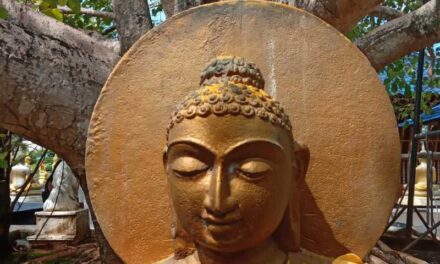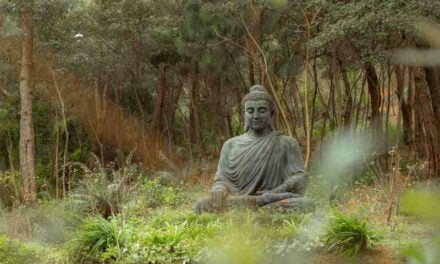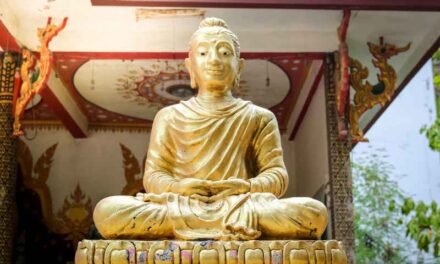Buddhist art, a captivating blend of aesthetics and spirituality, has graced the world for over two millennia. Originating in the Indian subcontinent, it embarked on a transformative journey, adapting and evolving as Buddhism spread across diverse cultures and geographies . This exploration delves into the enchanting world of Buddhist art, examining its origins, regional styles, symbolism, materials, techniques, and profound religious significance.
Origins and Evolution of Buddhist Art
Buddhist art emerged in the northern Indian subcontinent a few centuries after the life of Siddhartha Gautama (6th-5th century BCE) . In its early phase, Buddhist art was largely aniconic, meaning that artists refrained from depicting the Buddha in human form . Instead, they relied on symbolic representations to convey his presence and teachings. These symbols included footprints, an empty throne, and the Bodhi tree, each carrying profound meaning . This aniconic phase stemmed from the belief that portraying the Buddha anthropomorphically would distract from his teachings and the path to enlightenment .
Around the 1st century CE, a shift occurred, and anthropomorphic representations of the Buddha began to emerge in northern India . This shift might be linked to the influence of Hellenistic culture, brought to the region through trade and conquest, as well as the development of Mahayana Buddhism, which emphasized the Buddha as a compassionate savior . The Gandhara region, influenced by Hellenistic art, portrayed the Buddha with youthful features and flowing robes, reminiscent of Greek sculptures . In contrast, the Mathura school developed a more indigenous style, emphasizing symbolic qualities and drawing inspiration from earlier Indian traditions . These early representations laid the foundation for the iconic phase of Buddhist art, which flourished and diversified as Buddhism spread across Asia .
Regional Styles of Buddhist Art
India
Buddhist art in India flourished alongside Hindu and Jain art, with cave temple complexes showcasing the interplay of these traditions . The Gandhara and Mathura schools laid the groundwork for later styles, such as the Gupta period (4th-6th century CE), known for its refined sculptures with delicate features and transparent robes . The Amaravati school in southern India developed a distinct style with robust figures and a focus on narrative reliefs, depicting scenes from the Buddha’s life and previous lives .
China
Buddhism arrived in China around the 1st century CE, introducing new artistic expressions . Chinese Buddhist art integrated indigenous traditions with foreign influences, resulting in a unique visual language . Cave temples, such as the Yungang Grottoes and Longmen Grottoes, showcase intricate carvings and sculptures, often on a grand scale . Chinese Buddhist art often depicts a rich pantheon of Buddhas, bodhisattvas, and celestial beings, reflecting the influence of Mahayana Buddhism, which emphasizes the bodhisattva path and the liberation of all beings .
Japan
Buddhist art in Japan blossomed after the introduction of Buddhism in the 6th century CE . Early Japanese Buddhist art drew inspiration from Chinese and Korean styles, as seen in the sculptures of the Asuka period . The Nara period witnessed the construction of grand temple complexes, such as Todai-ji, with its colossal bronze statue of the Great Buddha . Later periods, such as the Heian and Kamakura, saw the development of distinctive Japanese styles in sculpture and painting, with a focus on realism and emotional expression . Zen Buddhism, a prominent school in Japan, influenced artistic expressions through portraiture of priests, scroll calligraphy, and sumi-e brush painting .
Tibet
Tibetan Buddhist art is deeply intertwined with Vajrayana Buddhism, characterized by its emphasis on tantric practices and a complex pantheon of deities . Thangka paintings, intricate scroll paintings on cloth, are a hallmark of Tibetan art, depicting Buddhas, bodhisattvas, mandalas, and religious narratives . Tibetan art also includes murals, sculptures, and ritual objects, often adorned with intricate details and vibrant colors . These vibrant colors and intricate details serve to both capture the eye and convey the multifaceted nature of Buddhist teachings.
Southeast Asia
Buddhist art in Southeast Asia reflects the influence of both Theravada and Mahayana Buddhism, resulting in diverse regional styles . The Khmer Empire in Cambodia left a legacy of magnificent temples, such as Angkor Wat, with its intricate bas-reliefs and towering structures . In Thailand, Buddhist art is characterized by elegant stupas, often adorned with gold leaf, and graceful Buddha images .
Symbolism and Iconography in Buddhist Art
Buddhist art employs a rich vocabulary of symbols and iconography to convey religious teachings and inspire devotion. The Buddha himself is often depicted with specific attributes, such as elongated earlobes, a cranial bump (ushnisha), and hand gestures (mudras) . Each mudra carries a symbolic meaning, representing different aspects of the Buddha’s teachings or moments in his life . For example, the Bhumisparsha mudra represents the Buddha’s enlightenment, while the Dharmachakra mudra symbolizes the turning of the wheel of Dharma .
Bodhisattvas, enlightened beings who postpone Buddhahood to help others, are often depicted with distinctive attributes and iconography . Avalokiteshvara, the bodhisattva of compassion, is often portrayed with multiple arms and heads, symbolizing his ability to perceive and alleviate suffering in all realms of existence . Manjushri, the bodhisattva of wisdom, is often depicted with a sword, representing the cutting through of ignorance .
Mandalas, intricate geometric diagrams, represent the cosmos and serve as aids for meditation and visualization . They often depict Buddhas, bodhisattvas, and other deities arranged in a symbolic order, reflecting the interconnectedness of all things .
In addition to these iconic figures, Buddhist art often incorporates the Eight Auspicious Symbols, each carrying a unique meaning :
- The Precious Parasol: Symbolizes protection from evil and suffering.
- The White Conch Shell: Represents the spreading of the Dharma, like the sound of the conch shell.
- The Two Golden Fish: Symbolize liberation from suffering and the cycle of rebirth.
- The Knot of Eternity: Represents the intertwining of wisdom and compassion.
- The Vase of Great Treasures: Symbolizes abundance, prosperity, and the fulfillment of wishes.
- The Victory Banner: Represents the victory of the Dharma over ignorance and delusion.
- The Lotus Flower: Symbolizes purity, enlightenment, and the potential for spiritual growth.
- The Eight-Spoked Wheel: Represents the Noble Eightfold Path, the path to liberation.
Materials and Techniques in Buddhist Art
Buddhist art encompasses a wide range of materials and techniques, reflecting the diversity of Buddhist cultures and artistic traditions. Sculpture is often created using bronze, stone, wood, and clay, with each material carrying symbolic meaning . Bronze, known for its durability, is often used for statues and ritual objects . Stone, symbolizing permanence, is often used for sculptures and architectural elements . Wood, reflecting the impermanence of life, is often used for sculptures and temple structures .
Painting techniques vary across regions and traditions. Thangka paintings in Tibet are often created using mineral pigments on cloth, while murals in temples and monasteries are often painted on walls using a variety of techniques . In East Asia, Buddhist paintings often employ ink and color on silk or paper, with a focus on calligraphic brushwork .
Buddhist Architecture
Buddhist architecture is as diverse as the cultures and regions where Buddhism has flourished. Early Buddhist architecture is associated with three main types of structures: monasteries (viharas), stupas, and prayer halls (chaityas) . Monasteries serve as residences for monks and nuns, providing spaces for communal living, study, and meditation. Stupas are dome-shaped structures that house relics of the Buddha or other important figures, serving as places of veneration and pilgrimage. Prayer halls are enclosed spaces for communal worship and meditation, often containing stupas and statues.
As Buddhism spread, architectural styles evolved, incorporating local traditions and influences. In India, cave temples carved into cliffs became prominent, while in Southeast Asia, towering temple complexes like Angkor Wat emerged . Tibetan Buddhist architecture features distinctive monasteries with sloping walls and vibrant colors, while Japanese Buddhist temples often reflect Shinto influences and emphasize wooden architecture .
Cultural and Religious Significance of Buddhist Art
Buddhist art is deeply intertwined with the teachings and values of Buddhism. It serves as a visual expression of religious beliefs, inspiring devotion and providing a focus for meditation and spiritual practice . The creation of Buddhist art is often seen as an act of merit, accumulating positive karma for the artist and the patron .
Buddhist art also plays a role in transmitting religious teachings and narratives. Sculptures and paintings often depict scenes from the life of the Buddha, illustrating key moments and teachings . Mandalas serve as visual representations of the cosmos and aid in understanding complex Buddhist concepts . In Zen Buddhism, the creation of art itself can be a form of practice and meditation, expressing the concept of impermanence and the interconnectedness of all things .
Famous Buddhist Artworks
| Region | Artwork | Description |
|---|---|---|
| India | Standing Buddha from Gandhara | This iconic statue, dating back to the 1st century CE, showcases the influence of Hellenistic art on Buddhist sculpture in the Gandhara region. |
| India | Dharmachakra Pravartana Buddha at Sarnath | This sculpture, from the Gupta period, depicts the Buddha giving his first sermon at Sarnath, symbolizing the turning of the wheel of Dharma. |
| China | Seated Buddha, probably Shakyamuni (Shijiamouni) | This sculpture, from the late 4th or early 5th century CE, exemplifies the Chinese style of Buddhist sculpture, with its serene expression and flowing robes. |
| China | Buddha Maitreya (Mile) | This statue, from the late 5th century CE, depicts Maitreya, the future Buddha, reflecting the Chinese emphasis on hope and future enlightenment. |
| Japan | Great Buddha of Kamakura (Kamakura Daibutsu) | This colossal bronze statue, completed in 1252, represents Amida Buddha and symbolizes peace and enlightenment. |
| Japan | Guze Kannon at Horyuji Temple | This 7th-century statue depicts Kannon, the bodhisattva of compassion, showcasing intricate details and serene expressions. |
| Tibet | Portrait of a Lama, Possibly Dromton | This thangka painting, from the 11th or 12th century, depicts a revered lama, reflecting the importance of lineage and spiritual teachers in Tibetan Buddhism. |
| Tibet | Mandala of Jnanadakini | This 14th-century thangka painting depicts a mandala of Jnanadakini, a female deity representing wisdom and spiritual realization. |
| Southeast Asia | Seated Gautama Buddha at Borobudur | This 8th- or 9th-century stone sculpture, from the Borobudur temple in Indonesia, depicts the Buddha in a meditative pose, reflecting the influence of Indian Gupta art. |
| Southeast Asia | Relief of a smiling Buddha at Bayon Temple | This 9th- to 13th-century bas-relief, from the Bayon Temple in Cambodia, depicts the Buddha with a serene smile, characteristic of Khmer art. |
Further Reading
- Behrendt, Kurt. How to Read Buddhist Art. New York: The Metropolitan Museum of Art, 2019.
- Chicarelli, Charles F. Buddhism and Buddhist Art: An Illustrated Introduction. Bangkok: Silkworm Books, 2006.
Buddhist art is a captivating expression of spirituality and aesthetics, encompassing a rich tapestry of regional styles, symbolism, materials, and techniques. From its origins in the Indian subcontinent to its diverse manifestations across Asia, Buddhist art has played a pivotal role in shaping religious beliefs, cultural traditions, and artistic expressions. Its enduring legacy continues to inspire and enchant, offering a glimpse into the profound world of Buddhist thought and practice. By serving as a bridge between the physical and spiritual realms, Buddhist art reflects the core values of Buddhism, such as compassion, wisdom, and the pursuit of enlightenment, while showcasing the diversity of its artistic traditions across cultures and throughout history.Sources and related content





